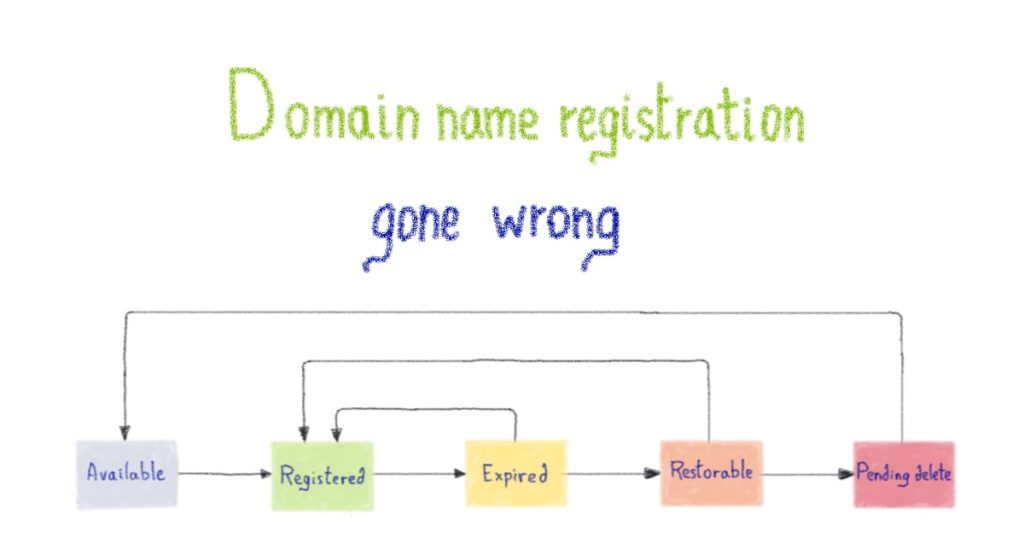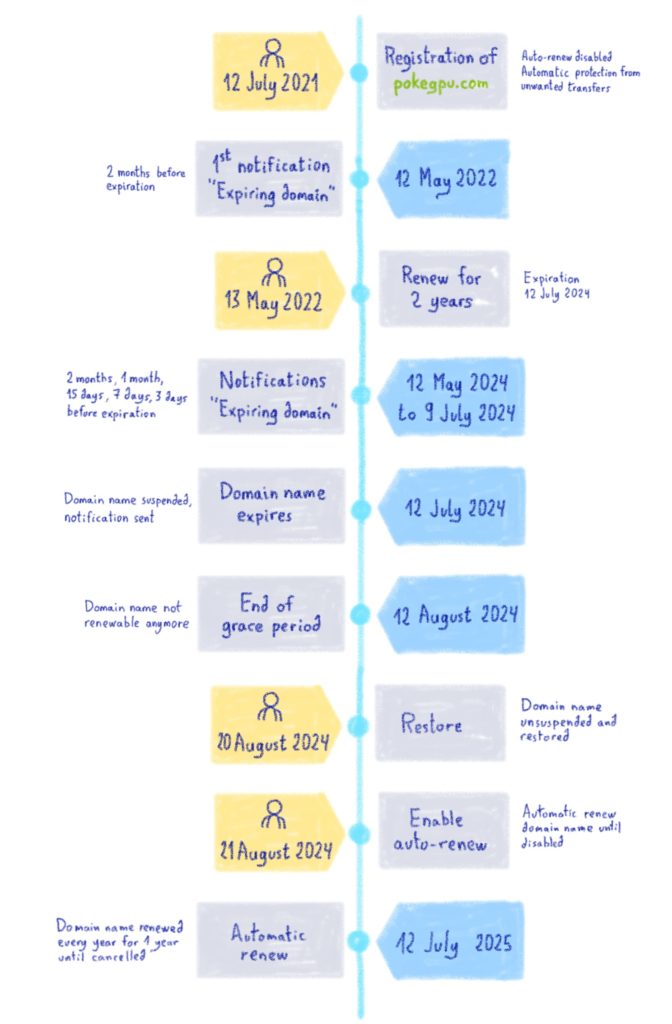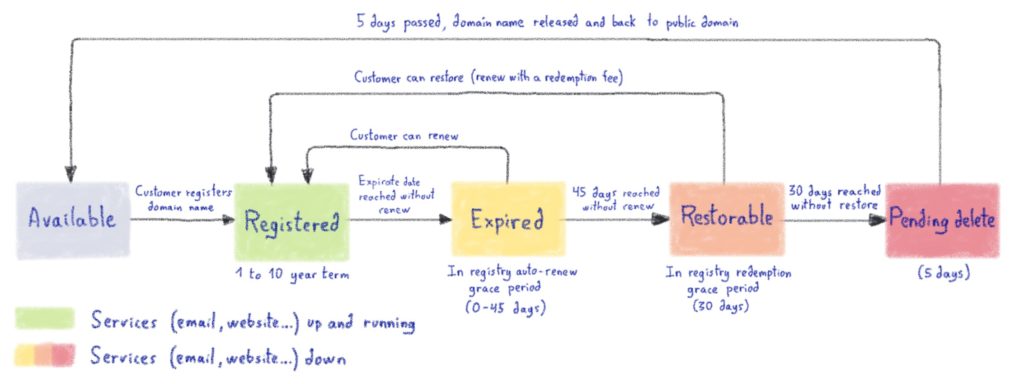In the last article, we introduced you about what a domain name is, what entities are involved and what the purpose of the Whois is.
As seen previously, OVHcloud is a registrar. As a registrar, our work is very similar to that of a real estate agency. We connect tenants (registrants) with landlords (registries) and get a margin for each transaction. As a registrant, when you order a new domain name, you rent it for a given period (often 1 year), which can be extended until you don’t want it anymore.

In this article, we will show you what happens behind the scenes when you order and manage a domain name. Through a story, we will explain what the domain lifecycle is and how we interact with registries.
Lifecycle
Let’s say you read our blog article about the anatomy of GPUs using Pokémon, and want to start a business selling GPU Pokémon cards. You spent a lot a time thinking about the best domain name to register, and came up with pokegpu.com
Our story starts on the 12th July 2021, you are ready to start your business. You go to the OVHcloud website and search this domain name.
In the following sections, for readability, periods of 30 and 60 days will be simplified respectively as 1 month and 2 months. It means that when 1st August is increased by 30 days, it will appear as 1st September and not 31th August.
2021 – Domain Name Registration
First of all, when you search for pokegpu.com, OVHcloud information system will make a check to ensure that:
- We sell the .com extension
- There is no ongoing maintenance on the registry backend, Verisign in the case of .com.
- The domain is available on the registry backend (also known as “Domain Check”)
Luckily, no one seems to want to sell GPU Pokémon cards, so you are free to order the domain name. Once the order is paid, we are able to start the creation of your domain name.
Depending on the extension, you may have to fulfill some requirements, like being a European Union citizen or resident for .eu extension (more on this in the next article). For the .com extension, no need to worry, the extension is available for everyone and there are no specific requirements.
On OVHcloud side, we will create the reference of your domain internally, and communicate with the registry backend by sharing some elements:
- Contacts data: owner, administrator, technical (more details about this in our next article)
- Dates of creation and expiration
- DNS servers (set by default or personalized in the order funnel)
In this creation phase, an anonymized working version of your email is sent to the registry backend, so you can avoid spam by regenerating another if needed.
If transmitted information is correct, the creation of your domain is finalized in a short time.
Finally, by default, we transparently protect the domain name from unwanted transfers, by sending a command to the registry backend. So you will need to deliberately disable the protection if you want to transfer your domain name to another registrar.
As this is a new business and you are not sure that the company is viable, you decide to disable the OVHcloud auto-renew. It means the domain will have to be manually renewed before expiration, otherwise it will be deleted. Don’t worry, you will be notified before it happens.
It will require a manual renewal before 12th July 2022.
2022 – First Domain Renew
We are now 10 months later (60 days before expiration), the 12th May 2022. Nice, your business works well and you sell your PokeGPU cards all around the world .
But pokegpu.com is almost expired, so you receive a first notification. As you want to keep selling cards, you renew the domain name the 13th May 2022 for 2 years.
A renewal command is sent by our system to Verisign which adds two years to the expiration date.
It will now expire the 12th July 2024.
2024 – Forgotten Renewal
Two years have passed, you now have refocused on another business leaving the sale of GPU Pokémon cards aside for now. And in doing so, even after all the notifications (60 days, 30 days, 15 days, 7 days and 3 days prior to the expiration), you forgot to manually renew your domain name. The domain name expires the 12th July 2024.
This domain name, as well as the other gTLDs, are by default automatically renewed by the registry using the “registry auto-renew” feature. When the domain name expires, it’s renewed on the registry side, and an auto-renew grace period starts for up to 45 days, during which registrars can request the deletion of the domain name so that they are not charged for the renew.
It has to be differentiated from the OVHcloud auto-renew feature. OVHcloud auto-renew is possible on gTLDs extensions but also on the ones which do not support registry auto-renew. Here is a matrix to summarize which cases are possible and how the workflow changes.
| Registry auto-renew enabled (gTLDs) | Registry auto-renew disabled or absent (ccTLDs) | |
|---|---|---|
| OVHcloud auto-renew enabled | We synchronize our system on registry expiration date, but don’t interact with the registry backend. It’s transparent on your end. | We send an explicit renewal request automatically for you before expiration. It’s transparent on your end. |
| OVHcloud auto-renew disabled | If you do not renew within 30 days after expiration, we send an explicit deletion request to the registry. This will make the domain name fall in redemption grace period for 30 days. In this period, the domain name can still be restored from the registry with additional fees. | We let the domain name fall in redemption grace period if you do not renew it. From ccTLDs registry to another, periods may differ and restore may be possible or not. |
Let’s come back to what happened for the expiration of your domain pokegpu.com:
- As a registrar, when the expiration date was reached, we sent a command to suspend the domain name to the registry. This made the domain name unavailable, as well as the services hosted behind it (email, website…)
- As it’s a gTLD, we waited for 30 days to let you renew the domain, in order to give you a the opportunity to renew during the auto-renew grace period
- As it was not renewed during this period, we sent an explicit command to request deletion of the domain name to the registry. The domain name then fell in redemption grace period for 30 days. During this period, the domain name can still be restored from the registry
Now you have two choices:
- You let it expire and 5 days after the end of redemption, it will be available again for registration by anyone (even by a malicious person)
- You absolutely do not want to take the risk of losing the domain name and ask for a restore
2024 – Restoration
The domain is suspended and almost lost, it will return to the public domain in a couple of days. Grace period of 30 days expired, but the domain name can be restored. You don’t want to take the risk of having it taken over by someone else, so after some days of thought, you decide to keep your domain name for a little longer and explicitly restore the domain on the 20th August 2024.
This action is very similar to the renewal, but registries often ask for a much more expensive price (about 400% increase for .com).
A restore command is sent to Verisign, which adds one year to the expiration date and reactivates the domain name. After the operation, the domain name is fully working and related hosted services become available again.
2024 – Secure renew with OVHcloud auto-renew
To avoid such trouble, at OVHcloud we decided to enable the OVHcloud auto-renew feature by default for new domain name registrations.
On the 21st August 2024, you decide to re-enable it. As long as a valid payment method is configured on your account, the domain name will be automatically renewed every year without any action on your end.
You can now focus on your new business with peace of mind . The domain will be renewed on the 12th July 2025, the anniversary of the creation date, and in the following years until you decide not to.
Summary
Here is a timeline summarizing what happened:

This timeline happened because a gTLD domain name lifecycle corresponds to the following simplified graph.

- Domain name is available for registration to everyone
- Domain name is registered for 1 to 10 years. The domain can be renewed by the customer in this period. If the expiration date is reached without renew, the domain name expires
- Domain name is expired. It’s suspended and services hosted behind it are not available anymore. When the registry auto-renew feature is activated (to not mix up with OVHcloud auto-renew), registrars have up to 45 days to cancel the automatic renewal. At OVHcloud, we give customers 30 days to renew
- Domain name is restorable. It’s still suspended and can be restored, which is similar to a renew but with redemption fees
- Domain name is blocked in deletion for 5 days. It’s still suspended, and domain name will be available again for registration at the end of the period
Conclusion
In this post, we talked about the lifecycle of a single domain name. But the truth is that this story only relates to the lifecycle of a gTLD. ccTLDs belong to a whole new world, often with eligibility rules and a custom lifecycle.
For instance, .es domain names don’t support automated restore, .it domain names have a renew grace period of 13 days, .pl domain names are not renewed on transfer… All these are special cases we need to integrate in our information system. As as registrar, our role is to lessen these differences by giving a standardized user experience to our customers.
In the next article, we will talk about eligibility rules and how some extensions cannot be owned by anyone.


